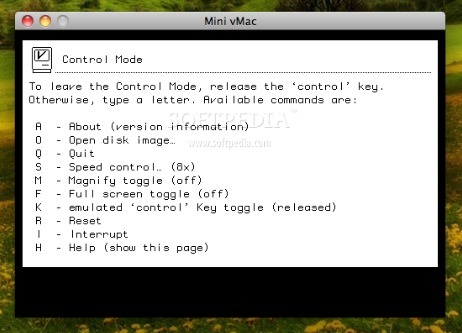
Insert the USB drive that you’ll use to fix your installation of OS X.

MINI VMAC BOOT DISK FULL
(If you want to support the developer, you can purchase the full version.) Quick note: TransMac is a paid software, but it has a 15-day trial solution that gives us more than enough time to move the DMG files to the USB drive from Windows. Type the following command to select the storage and press Enter: select disk 1 Type the following command to determine the USB flash drive and press Enter: list disk Type the following command to open Diskpart and press Enter: diskpart Search for Command Prompt, right-click the top result, and select the Run as Administrator option. Use these steps to set up a USB drive with a GPT partition: To do this, you’ll need to use the Diskpart command-line utility on Windows 10.
MINI VMAC BOOT DISK MAC OS X
Create Mac OS X bootable USB installation mediaīefore using TransMac, you first need to partition your USB flash drive with a GPT partition, as a normal MBR partition may not work. Now that you have all the necessary ingredients, you’re ready to make a Mac OS X bootable USB using the DMG file of the operating system with the steps below. One high-quality USB flash drive with 16GB of storage.Requirementsīefore you dive into this guide, you’ll need a few things:
MINI VMAC BOOT DISK UPGRADE
These instructions will also work for Windows users running Mac OS X on a virtual machine and needing to upgrade to the latest version. However, if you find yourself in a scenario where your device (iMac, MacBook Pro, Air, Mac Pro, or Mini) is not responding, and you happen to have a Windows 10 device, then you can still be able to make a USB bootable installation media for your Mac OS X to reinstall the operating system using the Recovery Assistant. This is why it’s recommended that you make a Mac OS X bootable USB when your Mac is in working conditions. I'm competent enough to follow directions very well, but only if they're dumbed-down a bit.If you’re still using a Mac OS X, the time will come when your computer won’t boot, or a problem may arise where you can’t take control of the device, and booting from an OS X installation media will be required. Please note I'm not a power user-and had never typed anything into a terminal command line before I ran into this problem and started searching - i.e. I feel like I'm so close, but can't get past this pesky read-only issue. I've tried various rm commands, but keep getting various slaps on the wrist that end in "Read-only file system"įor obvious reasons, I'd like to try to clear enough of the clutter on this drive in hopes of rebooting and then wiping out all the clutter I should have gotten rid of a while ago before going nuclear on it and risking losing everything. Tried /sbin/mount -uw / (as per this thread ) but I'm getting a long error message that ends in:

I've read where some people went into Single User mode and used the command line to delete some files they don't need. Before I could create a new TM backup, I left for a couple of days, came back and my startup disk was full and my Mini (mid-2011, Running Sierra) wouldn't boot. Short Version: I wiped my (time machine) external backup drive due to problems it was having. Hours of searching various forums have produced glimmers of hope, but nothing works.įirst - mea culpa - I have only myself to blame.


 0 kommentar(er)
0 kommentar(er)
